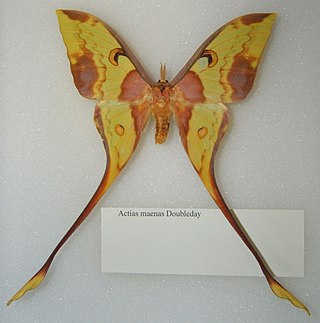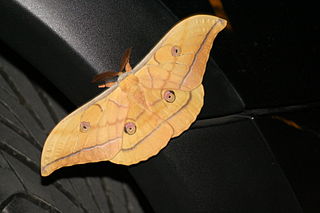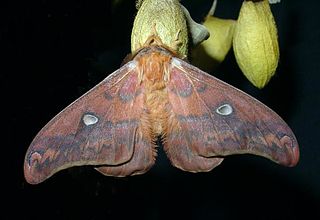
The domestic silk moth is an insect from the moth family Bombycidae. It is the closest relative of Bombyx mandarina, the wild silk moth. The silkworm is the larva of a silk moth. The silkworm is of particular economic value, being a primary producer of silk. The silkworm's preferred food are the leaves of white mulberry, though they may eat other species of mulberry, and even leaves of other plants like the osage orange. Domestic silk moths are entirely dependent on humans for reproduction, as a result of millennia of selective breeding. Wild silk moths are not as commercially viable in the production of silk.

The luna moth, also called the American moon moth, is a Nearctic moth in the family Saturniidae, subfamily Saturniinae, a group commonly named the giant silk moths.

Saturniidae, members of which are commonly named the saturniids, is a family of Lepidoptera with an estimated 2,300 described species. The family contains some of the largest species of moths in the world. Notable members include the emperor moths, royal moths, and giant silk moths.

The Malaysian moon moth is a Saturniid in the subfamily Saturniinae from Indomalaya. The male is purplish-brown and yellow, while the larger female is overall light green.

Actias is a genus of Saturniid moths, which contains the Asian-American moon moths. Long tails on their hindwings are among their distinctive traits. Other moths with similar appearance are Copiopteryx, Argema and Eudaemonia.

Actias isis is a moth of the family Saturniidae first described by Léon Sonthonnax in 1899.

Actias ningpoana, the Chinese moon moth, is a moth of the family Saturniidae. The species was first described by father-and-son entomologists Cajetan and Rudolf Felder in 1862. It is quite large, and has long, curved, hindwing tails. There are many congeners across Asia; the Luna moth of Eastern Canada and the United States is a close relative.

Actias sinensis, the Golden moon moth, is a moth of the Family Saturniidae. It is found in China, Taiwan, Vietnam, Myanmar, India and Thailand. The species was first described by Francis Walker in 1855.

The Saturniinae or saturniines are a subfamily of the family Saturniidae, also known as giant silkmoths. They are commonly known as emperor moths or wild silk moths. They are easily spotted by the eyespots on the upper surface of their wings. Some exhibit realistic eye-like markings, whilst others have adapted the eyespots to form crescent moon or angular shapes or have lost their wing scales to create transparent windows. They are medium to very large moths, with adult wingspans ranging from 7.5 to 15 cm, in some cases even more. They consist of some of the largest sized Lepidoptera, such as the luna moth, atlas moth, and many more. The Saturniinae is an important source of wild silk and human food in many different cultures.

Antheraea yamamai, the Japanese silk moth or Japanese oak silkmoth is a moth of the family Saturniidae. It is endemic to east Asia, but has been imported to Europe for tussar silk production and is now found in southeastern Europe, mainly in Austria, northeastern Italy, and the Balkans. It seems to be spreading north and a population has been reported near Deggendorf and Passau in Germany. The species was first described by Félix Édouard Guérin-Méneville in 1861. It has been hybridized artificially with Antheraea polyphemus of North America.

Antheraea pernyi, the Chinese oak tussar moth, Chinese tasar moth or temperate tussar moth, is a large moth in the family Saturniidae. The species was first described by Félix Édouard Guérin-Méneville in 1855. Antheraea roylei is an extremely close relative, and the present species might actually have evolved from ancestral A. roylei by chromosome rearrangement.

Actias neidhoederi is a moth belonging to the Actias Leach of Saturniidae. It is a species endemic to Taiwan.。

Actias gnoma, also known as the Japanese moon moth, is a moth in the family Saturniidae The species was first described by Arthur Gardiner Butler in 1877. It is found in Japan and the Russian Far East.

Actias groenendaeli is a moth of the family Saturniidae first described by Roepke in 1954. It is found in Indonesia.
Actias australovietnama is a moth in the family Saturniidae. It is found in Vietnam.
Actias callandra, the Andaman moon moth, is a moth in the family Saturniidae. It is found in India.

Actias chapae or colloquially known as the 'celestial moon moth' is a moth in the family Saturniidae. It is found in Vietnam and China and potentially other countries in the region; it is a montane species recorded from 1500m and higher. It appears to be an exclusive pine feeder and has been raised on many different species of Pinus in captivity.
Actias winbrechlini is a moth in the family Saturniidae. It is found in China (Yunnan) and Burma.

Rhodinia fugax, the squeaking silkmoth, is a moth in the family Saturniidae. It was described by Arthur Gardiner Butler in 1877. It is native to Korea, Japan, China, and the Russian Far East.

















